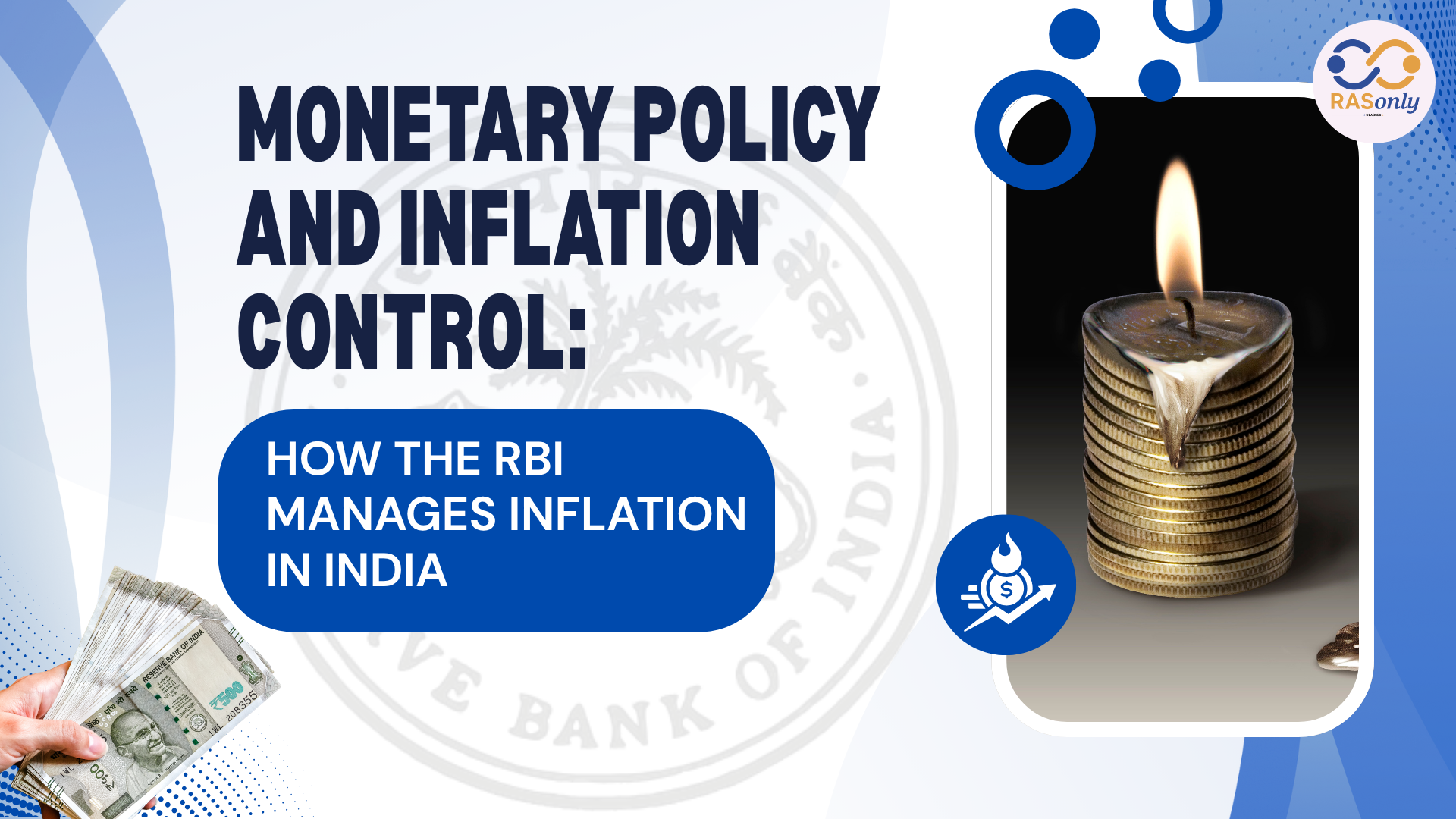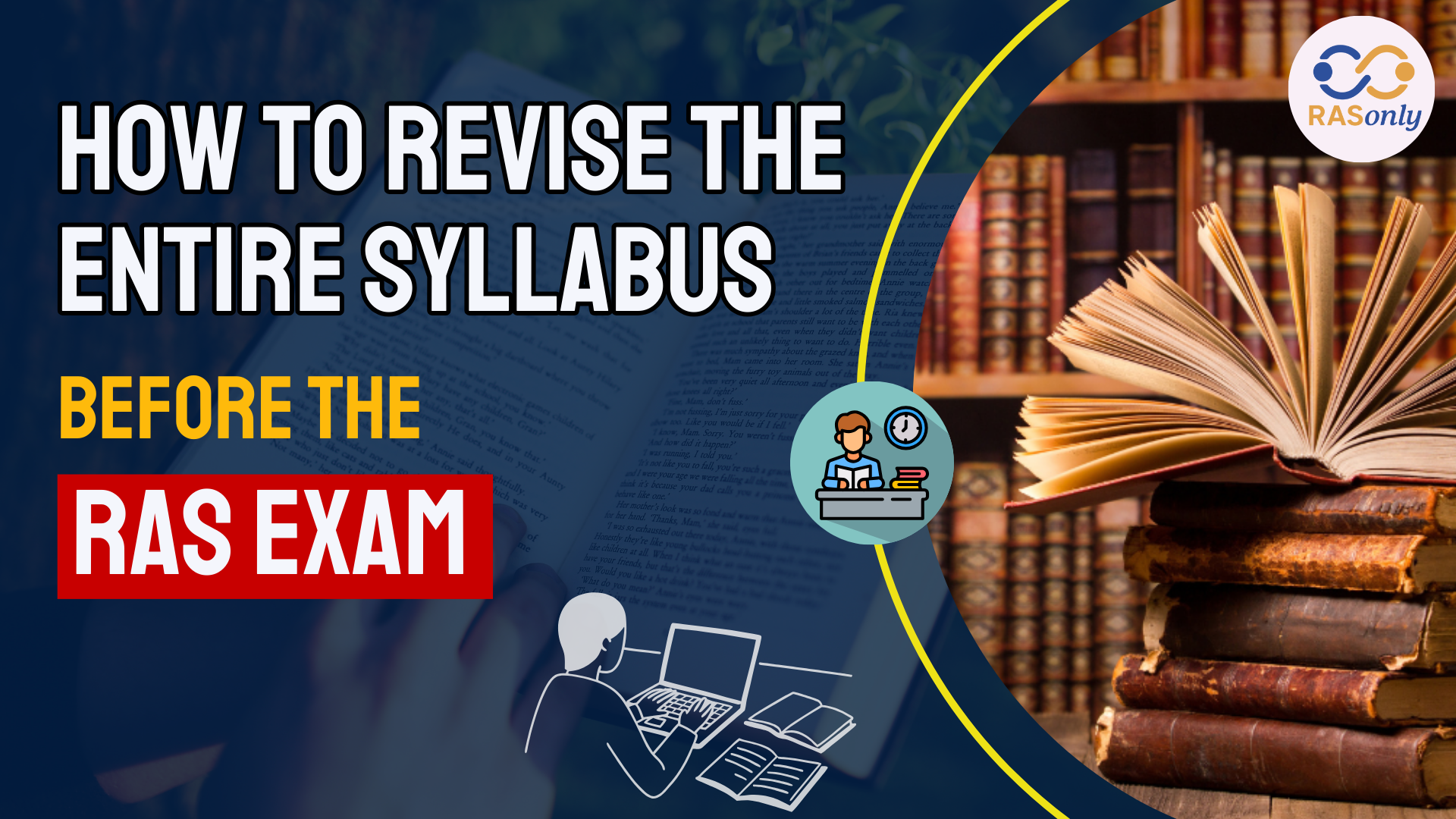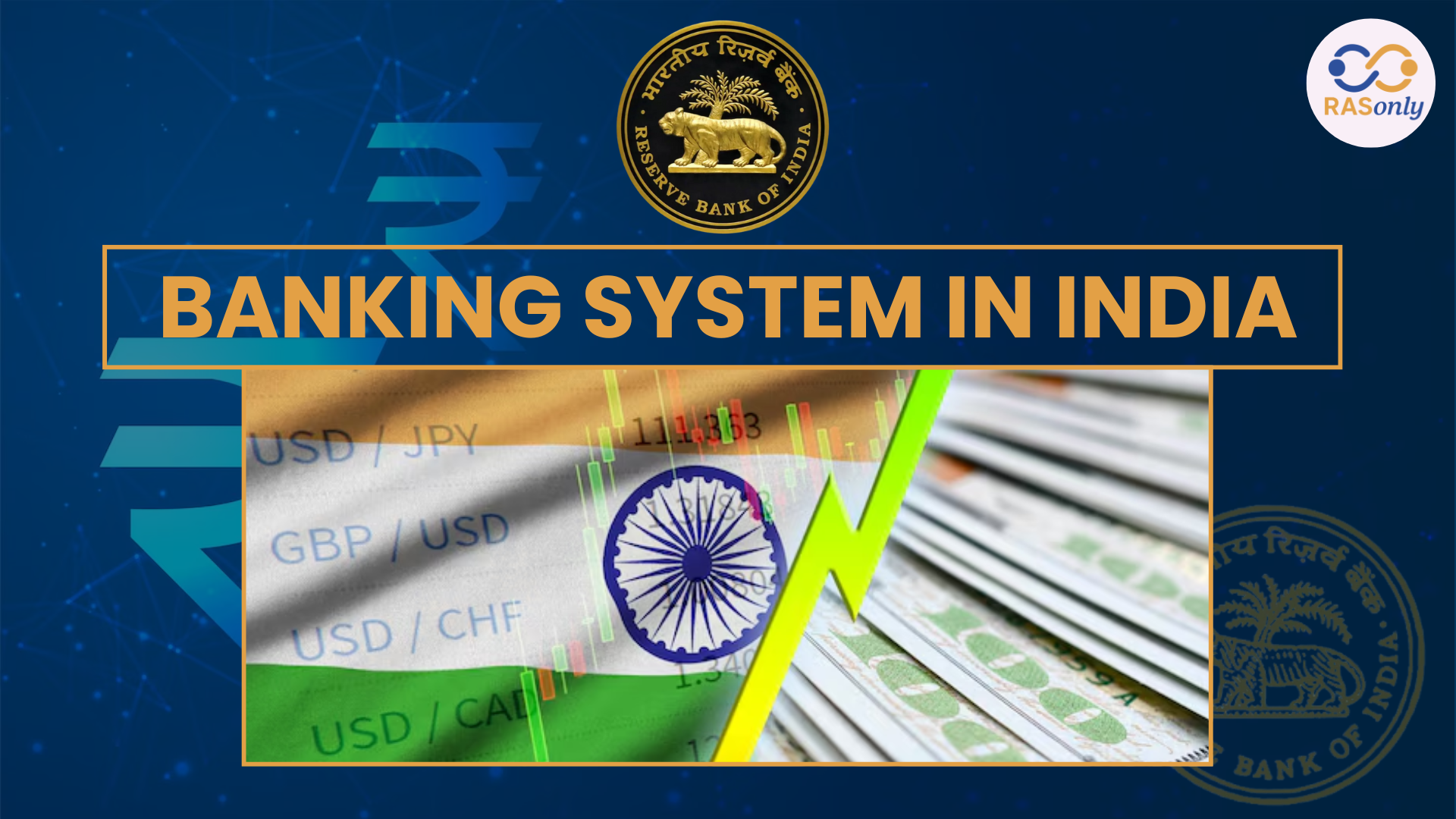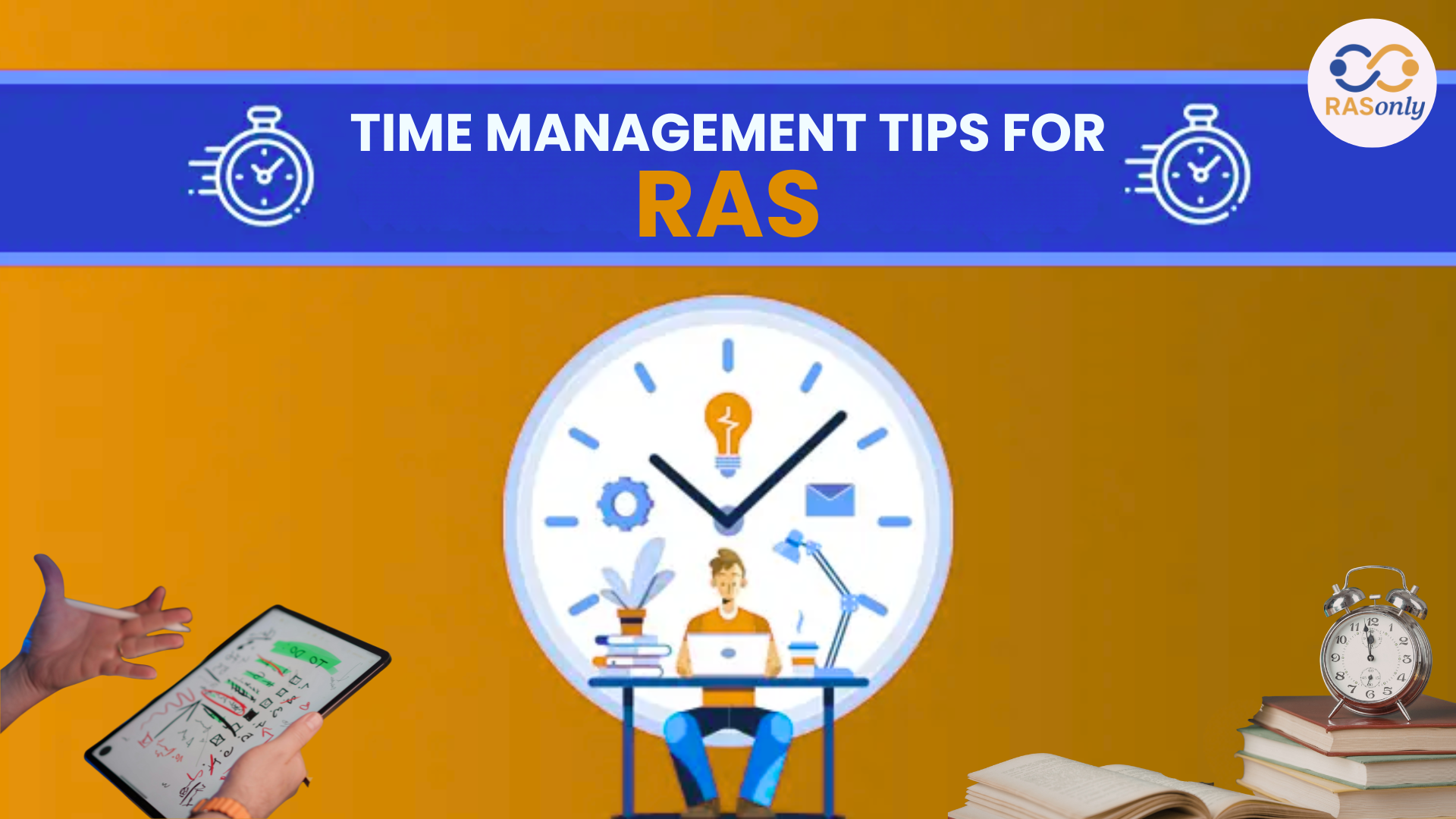How to Revise the Entire Syllabus Before the RAS Exam: A Complete Guide
Monetary Policy and Inflation Control: How the RBI Manages Inflation in India


One of the main goals of monetary policy in India is the control of inflation and the role of the Reserve Bank of India (RBI) in this process is rather important. Being the central bank of India, the RBI employs a number of monetary policy instruments that help in controlling inflation, keeping prices in check, and economic growth. Monetary policy and inflation are the two concepts that play key roles in the overall operation of the Indian economy and knowing how the RBI controls the inflation is relevant to aspirants who are going to take the RAS (Rajasthan Administrative Services) test.
Key Components of RBI's Monetary Policy
The RBI’s monetary policy framework is aimed at achieving the medium-term target of 4% inflation with a tolerance band of +/- 2%. This target was set by the Government of India in consultation with the RBI under the Inflation Targeting Framework, which came into effect in 2016. The RBI reviews inflation data regularly and adjusts policy rates and other tools to ensure that inflation remains within this target range.
The main objective of monetary policy is to maintain price stability while ensuring an adequate flow of credit to support economic growth. The RBI takes various steps to monitor and control inflation, including adjusting key interest rates, managing liquidity in the economy, and using other monetary policy instruments.
Key aspects of the monetary policy framework include:
- Inflation Targeting: The RBI aims to keep inflation under control and sets an inflation target that is reviewed periodically. This ensures that inflation expectations remain anchored and provides clarity to businesses and consumers.
- Monetary Policy Stance: The RBI decides whether to follow an accommodative (expansionary) or tightening (contractionary) stance based on current economic conditions.
- Monetary Policy Instruments: The RBI uses several tools to implement its policy stance, including interest rates, liquidity management, and exchange rate interventions.
- Communication: Transparency in policy decisions and clear communication from the RBI help to shape expectations and influence economic behavior.
Monetary Policy Instruments Used by the RBI to Control Inflation
The RBI uses a range of monetary policy tools to regulate inflation. These tools influence the cost of credit, the money supply, and the overall liquidity in the economy. The main tools used by the RBI to control inflation include the following:
1. Repo Rate:
The interest rate at which the RBI lends money to banks.
- To control inflation: The RBI increases the repo rate. This makes borrowing more expensive for banks, leading to higher interest rates for consumers and businesses. This reduces the amount of money in circulation, cooling down the economy and curbing inflation.
- To stimulate growth: The RBI decreases the repo rate, making borrowing cheaper and encouraging spending and investment.
2. Reverse Repo Rate
- Definition: The reverse repo rate is the rate at which the RBI borrows from commercial banks. It serves as a tool for managing short-term liquidity in the banking system.
- Impact: When the RBI raises the reverse repo rate, commercial banks are encouraged to park more funds with the RBI, thereby reducing the liquidity in the economy. This tool helps in controlling inflation by tightening liquidity.
3. Cash Reserve Ratio (CRR)
- Definition: The Cash Reserve Ratio (CRR) is the percentage of a commercial bank’s total deposits that must be maintained with the RBI as a reserve. It is a key tool to manage the banking system's liquidity.
- Impact: By increasing the CRR, the RBI reduces the amount of money that commercial banks can lend out, thereby controlling inflationary pressures. A higher CRR reduces credit availability, which helps in slowing down the economy when inflation is rising.
4. Statutory Liquidity Ratio (SLR)
- Definition: The SLR is the minimum percentage of a commercial bank’s net demand and time liabilities (NDTL) that must be maintained in the form of liquid cash, gold, or other approved securities.
- Impact: When the RBI raises the SLR, it reduces the amount of credit banks can extend to borrowers, which helps reduce inflationary pressures in the economy.
5. Open Market Operations (OMOs)
- Definition: OMOs refer to the buying and selling of government securities in the open market by the RBI.
- Impact: When the RBI sells government securities, it absorbs excess liquidity from the banking system, which helps in controlling inflation. On the other hand, buying securities injects liquidity into the system, which can be useful during deflationary periods.
Latest RBI Policy Rates - Repo Rate, Bank Rate, CRR, SLR
| Instrument | Percentage (%) |
|---|---|
| Policy Repo Rate | 5.50 |
| Standing Deposit Facility Rate (SDFR) | 5.25 |
| Marginal Standing Facility Rate (MSF) | 5.75 |
| Bank Rate | 5.75 |
| Fixed Reverse Repo Rate | 3.35 |
| Cash Reserve Ratio (CRR) | 3.75 |
| Statutory Liquidity Ratio (SLR) | 18.00 |
Monetary Policy Committee (MPC)
The Monetary Policy Committee (MPC) is a committee constituted by the Central Government and led by the Governor of RBI. The Monetary Policy Committee was formed with the mission of fixing the benchmark policy interest rate (repo rate) to restrain inflation within the particular target level. The RBI governor controls the monetary policy decisions with the support and advice of the internal team and the technical advisory committee.
Initially, the main decisions related to interest rates were taken by the Governor of RBI alone before the establishment of the committee. MPC was constituted under the Reserve Bank of India Act, 1934 as an initiative to bring more transparency and accountability in fixing the Monetary Policy of India. MPC conducts meetings at least 4 times a year and the monetary policy is published after every meeting, with each member explaining his opinions.
Inflation Control Mechanisms in India
The RBI takes several steps to control inflation and ensure that it remains within the target range. The RBI’s monetary policy tools, such as the repo rate, reverse repo rate, and OMOs, are all used to influence the money supply and manage inflation.
Some key inflation control mechanisms used by the RBI include:
- Inflation Monitoring: The RBI continuously monitors inflation data, including CPI and WPI, to assess the current inflationary trends and take corrective actions as necessary.
- Monetary Policy Adjustment: The RBI adjusts the repo rate, reverse repo rate, and other policy tools based on the prevailing inflation conditions to either curb inflation or stimulate economic activity.
- Liquidity Management: The RBI uses OMOs, CRR, and SLR adjustments to manage liquidity in the banking system. Tightening liquidity through these tools helps in controlling excess demand in the economy, which is a key driver of inflation.
- Forward Guidance: The RBI provides forward guidance to the market, indicating its future monetary policy stance. This helps in managing inflation expectations and influencing the behavior of businesses and consumers.
Summary Table
|
Instrument |
Definition |
Impact on Inflation Control |
|
Policy Repo Rate |
Rate at which RBI lends to commercial banks |
Higher rate reduces borrowing, curbing inflation |
|
Reverse Repo Rate |
Rate at which RBI borrows from commercial banks |
Higher rate encourages banks to park funds with RBI, reducing liquidity |
|
Cash Reserve Ratio (CRR) |
Percentage of deposits that banks must maintain as reserves with RBI |
Higher CRR limits bank lending, controlling inflation |
|
Statutory Liquidity Ratio (SLR) |
Percentage of liabilities banks must maintain in liquid assets |
Higher SLR reduces bank lending capacity, helping inflation control |
|
Open Market Operations (OMOs) |
Buying and selling of government securities in the open market |
Selling securities absorbs liquidity; buying injects liquidity |
Conclusion
The RBI’s monetary policy plays a crucial role in maintaining price stability and fostering economic growth in India. By employing various monetary policy tools, the RBI manages inflation, ensuring the economy remains stable while supporting growth. For RAS aspirants, understanding these mechanisms is essential, as they form an important part of the Economy section in the exam.
For accurate and updated information, always refer to the official RBI website: https://www.rbi.org.in
Post Category
- RAS Salary
- Result
- RAS Admit Card
- RAS Job
- RAS Cutoff
- Preparation Tips
- RAS Answer Key
- RAS Exam Analysis
- RAS Syllabus
- RAS Previous Year Papers
- RPSC RAS Exam Pattern
- RAS Interview
- RAS Mains Exam Date
- RAS Vacancy
- RAS Test Series
- RAS Best Books
- RAS Preparation Resources
- RAS Coaching Centre
- History
- Polity
- Geography
- Economics
- Science
- Art and Culture
- RPSC RAS Application Form
RASonly Interview Guidance Program

Mr. Ashok Jain
Ex-Chief Secretary Govt of Rajasthan
- IAS officer of the 1981 batch, Rajasthan cadre.
- Passionate about mentoring the next generation of RAS officers with real-world insights.
- Got retired in Dec 2017 from the post of Chief Secretary of the state of Rajasthan.

Mr. Guru Charan Rai
Ex-ASP / SP in Jaisalmer
- Guru Charan Rai, IPS (Retd), retired as Inspector General of Police (Security), Rajasthan, Jaipur in 2017.
- Served as ASP and SP in Jaisalmer, Nagaur, Sri Ganganagar, Sawai Madhopur, Dausa, Sikar, and Karauli.
- He also held key positions as DIGP and IGP in the Law and Order division.

Mr. Rakesh Verma
Ex-IAS Officer, B.Tech, MBA, and M.A. (Economics)
- IAS officer of the 1981 batch and retired in Chief Secretary Rank.
- Civil servant of high repute and vast experience.
- Has been teaching UPSC CSE subjects for the last six years.
Related Post
👉🏻 Register Today to Join Classes! 👍🏻
- Team RASOnly -
🎯 Benefits of RASOnly Coaching:
- ✅ 1:1 Mentorship with RAS Officers
- ✅ Experienced and Expert Faculty
- ✅ Free Library Access
- ✅ Daily Minimum 4 Hours Must
- ✅ Comprehensive Study Material
- ✅ Regular Tests & Performance Analysis
- ✅ Personalized Guidance & Doubt Solving
- ✅ Online & Offline Class Options
- ✅ Affordable Fees with Quality Education
Key Highlights:
- 👉🏻 3-Day Refund Policy
- 👉🏻 New Batch Starting from 04 August
- 👉🏻 Registration Amount: Only ₹1000





